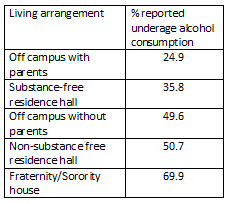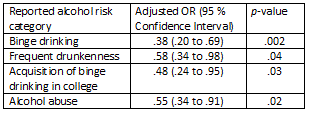Half of college binge drinkers adopt these bingeing behaviors before entering college, the other half develop this pattern during college (Weitzman et al. 2003b) and, despite the large variation of bingeing rates across colleges (ranging from 1% to 76%), within-college rates have remained constant for more than a decade (Wechsler et al., 2002b). College environmental factors likely play an important role in the problem drinking of this high-risk group. This week’s DRAM summarizes the key findings about the influence of environmental factors and students’ bingeing patterns from a review of the landmark Harvard School of Public Health’s College Alcohol Study (CAS) and also discusses the implications for drinking-related preventions and interventions among college students (Wechsler & Nelson, 2008).
Methods
- Participants (n ~ 50,000) were college students recruited as part of a nationally representative sample of 120 4-year colleges across the United States.
- Researchers distributed four national surveys to college student participants, first in 1993, and again in 1997, 1999, and 2001.
- These surveys assessed college students’ alcohol consumption and related drinking behaviors. The surveys contained the following measures of alcohol consumption:
- Binge drinking- defined as five or more consecutive drinks for men and four or more drinks in a row for women (this is known as the “Five/Four Rule”) on one or more occasions during the two weeks prior to completion of the survey
- Frequent binge drinking– bingeing on three or more occasions during the two weeks prior to the survey
- Number of drinking occasions during the past 30 days
- Number of drunken occasions during the past 30 days
- Usual number of drinks consumed during each occasion
- Researchers also obtained information on the contextual factors of each college environment.
Results
- Most alcohol-related injuries (53%) and adverse consequences occurred among students who satisfied the Five/Four Rule. Among respondents who reported alcohol-related injuries 21% consumed eight or more drinks in a row.
- The following college-level contextual factors influenced the prevalence of students’ problem drinking:
- College residence: Underage students living at home had the lowest rates of alcohol consumption (see Figure 1). The highest rate was among students living in fraternities and sororities.

Figure 1. Underage students’ alcohol consumption by college residence (n=4,231) (adapted from Wechsler et al., 2002b). Click image to enlarge.
- Demographics of the student body: Specifically, higher percentages of racial and ethnic diversity, females, and older students were correlated with lower rates of binge drinking among students, even after controlling for survey year, gender, underage status, and race (Wechsler & Kuo, 2003) (see Figure 2).

Figure 2. Correlation between college students’ binge drinking rates and demographic distribution across all four survey years (adapted from Wechsler & Kuo, 2003). Click image to enlarge.
- Volunteerism: In multilevel multivariate analyses that controlled for individuals’ levels of volunteering, the level of student volunteerism, or social capital, was associated inversely with alcohol use and drinking-related consequences (Weitzman and Chen, 2005). The odds for students with social capital favor the absence of the risky behavior (all ORs less than 1.0) (see Figure 3).

Figure 3. Reduced risks for students enrolled in colleges with higher levels of social capital (adapted from Weitzman & Chen, 2005). Note: OR = Odds ratio. Click image to enlarge.
- Campus drinking policy: College students attending “dry” campuses that ban alcohol had a higher frequency of abstainers, but the students who drank at these schools drank at high levels similar to those in colleges without the alcohol ban.
Limitations
- Students’ response rates declined across the four national surveys and also varied among colleges within each survey year, so the sample was not consistent.
- Additionally, a small number of students were sampled within each college, raising the possibility that these estimates do not accurately represent each of the schools.
- Lastly, the survey included only self-report measures of alcohol consumption. Future research might benefit from the inclusion of other independent and perhaps more objective measures of alcohol use among this high-risk group.
Discussion
The findings that environmental factors play a key role in predicting college students’ drinking and consequences suggest the need for a broader, community approach to addressing college drinking. For example, prevention efforts that target the unique college environment (e.g., evaluating traditions and college drinking policies) as well as other factors relating to students’ exposure to alcohol (e.g., aggressive marketing, number of liquor stores, availability of cheap alcohol) might be more effective than targeting individual behaviors of the heaviest drinkers.
— Brittany Bannon
What do you think? Please use the comment link below to provide feedback on this article.
References
Wechsler, H., & Nelson, T. F. (2008). What we have learned from the Harvard School of Public Health College Alcohol Study: Focusing attention on college student alcohol consumption and the environmental conditions that promote it. Journal of Studies on Alcohol and Drugs, 69(4), 481-490.
Wechsler, H., Lee, J. E., Kuo, M., Seibring, M., Nelson, T. F., & Lee, H. (2002b). Trends incollege binge drinking during a period of increased prevention efforts: Findings from 4 Harvard School of Public Health College Alcohol Surveys: 1993-2001. Journal of American College Health, 50, 203-217.
Wechsler, H., & Kuo, M. (2003). Watering down the drinks: The moderating effect ofcollege demographics on alcohol use of high-risk groups. American Journal of Public Health, 93, 1929-1933.
Weitzman, E. R., & Chen, Y. Y. (2000). Risk modifying effect of social capital on measure of heavy alcohol consumption, alcohol abuse, harms, and secondhand effects: National Survey Findings. Journal of Epidemiology and Community Health, 59, 303-309.
Weitzman, E. R., Nelson, T. F., & Wechsler, H. (2003b). Taking up binge drinking in college: The influence of person, social group, and environment. Journal of Adolescent Health, 32, 26-35.




